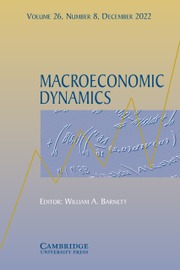Article contents
RELATIVE WEALTH, GROWTH, AND TRANSITIONAL DYNAMICS: THE SMALL OPEN ECONOMY CASE
Published online by Cambridge University Press: 20 September 2010
Abstract
In this paper we investigate the growth implications of relative wealth preferences in a small open economy model. Domestic capital accumulation, subject to installation costs, is the engine of economic growth in this framework. Crucial in deriving the balanced growth rate is the effective rate of return that arises from agents' status preferences. This results not only in a common balanced growth rate for consumption, the domestic capital stock, and net international financial assets, but also saddle-path dynamics in response to structural shifts. We investigate the short- and long-run dynamics of the model by considering the following standard fiscal shocks: (i) government expenditure, (ii) capital tax, (iii) tax on international financial assets, (iv) consumption tax. Among our results, we find that a permanent fiscal expansion leads to a temporary increase in growth and that a rise in the consumption tax results in a temporary decrease in growth.
Information
- Type
- Articles
- Information
- Macroeconomic Dynamics , Volume 14 , Supplement S2: Public Policy, Externalities, and Economic Growth , November 2010 , pp. 224 - 242
- Copyright
- Copyright © Cambridge University Press 2010
References
REFERENCES
- 5
- Cited by

